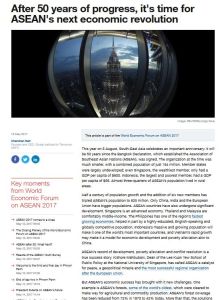Join getAbstract to access the summary!

Join getAbstract to access the summary!
Chandran Nair
After 50 Years of Progress, It’s Time for ASEAN's Next Economic Revolution
World Economic Forum, 2017
What's inside?
ASEAN countries have made significant advances in 50 years, but they still face major challenges.
Recommendation
The countries of the Association of Southeast Asian Nations (ASEAN) – which celebrates its 50th anniversary in 2017 – have made much progress since the group’s founding. Yet ASEAN members still face challenges: Rapid urbanization is straining the resources of major cities, small farmers in these countries are struggling to survive and deforestation adds to environmental sustainability issues. Author Chandran Nair looks at how far ASEAN countries have come and what they could do to accomplish more in the 21st century. getAbstract recommends this succinct analysis to policy makers and business executives interested in this region.
Summary
About the Author
Chandran Nair is the founder and CEO of the Global Institute for Tomorrow, a think tank.

















Comment on this summary